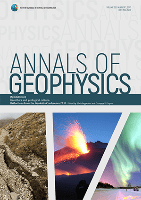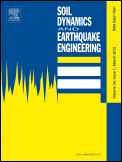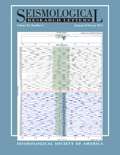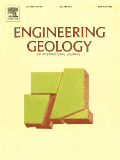
EARTHQUAKE SPECTRA
Scope & Guideline
Innovative insights into seismic phenomena and engineering.
Introduction
Aims and Scopes
- Seismic Performance and Resilience Analysis:
Research on the seismic performance of various structural systems, including reinforced concrete, masonry, and innovative materials, focusing on enhancing resilience and damage control during seismic events. - Ground Motion Prediction and Modeling:
Development and refinement of ground motion prediction models, including the analysis of site effects, stochastic simulations, and empirical data, to improve the accuracy of seismic hazard assessments. - Risk Assessment and Mitigation Strategies:
Studies aimed at evaluating seismic risk and developing mitigation strategies, including vulnerability assessments, economic impact analysis, and recovery planning for communities affected by earthquakes. - Innovative Engineering Solutions:
Exploration of new materials, construction techniques, and design methodologies that enhance the seismic performance of structures, including the use of machine learning and advanced computational methods. - Interdisciplinary Approaches to Earthquake Engineering:
Integration of geotechnical, structural, and socio-economic factors in the analysis of earthquake impacts, emphasizing the importance of a holistic approach to resilience and recovery.
Trending and Emerging
- Machine Learning and Data-Driven Approaches:
The application of machine learning techniques to predict seismic responses, assess vulnerability, and optimize design processes is gaining traction, showcasing the integration of artificial intelligence in earthquake engineering. - Real-Time Monitoring and Post-Event Assessment:
An increasing focus on real-time data collection and analysis for immediate post-earthquake assessments reflects the growing importance of rapid response strategies in mitigating disaster impacts. - Community Resilience and Socioeconomic Impacts:
Research exploring the social dimensions of seismic risk, including community preparedness, recovery inequalities, and the economic implications of seismic events, is emerging as a critical area of study. - Advanced Simulation Techniques:
The use of high-performance computing for sophisticated simulations of ground motion and structural responses is trending, enabling more accurate predictions of earthquake impacts on various infrastructures. - Interdisciplinary Collaboration:
There is a noticeable trend towards interdisciplinary research that combines insights from engineering, geology, social sciences, and urban planning to create comprehensive strategies for earthquake resilience.
Declining or Waning
- Traditional Seismic Design Codes:
Research focused on conventional seismic design codes appears to be declining as the field shifts towards performance-based design and innovative engineering solutions that prioritize resilience over compliance with standard codes. - Historical Case Studies of Earthquake Damage:
While historical analyses of past earthquakes were once prevalent, there is a noticeable reduction in studies that focus solely on retrospective assessments, as current research emphasizes predictive modeling and real-time analysis. - Basic Ground Response Analysis Techniques:
The use of simplistic methods for ground response analysis is waning as researchers increasingly adopt more complex, data-driven approaches that incorporate site-specific characteristics and advanced computational techniques.
Similar Journals

ANNALS OF GEOPHYSICS
Innovating Solutions for Environmental ChallengesANNALS OF GEOPHYSICS is a prestigious open access journal dedicated to the advancement and dissemination of research in the field of geophysics. Published by the IST NAZIONALE DI GEOFISICA E VULCANOLOGIA in Italy, this journal has embraced open access since its inception in 1948, promoting wide accessibility to cutting-edge research. With an impressive Scopus ranking, placing it in the 52nd percentile within Earth and Planetary Sciences for the category of Geophysics, the journal serves as a vital platform for scholars, researchers, and practitioners seeking to explore the intricate phenomena of our planet. Covering a diverse range of topics in the geophysical community, the ANNALS OF GEOPHYSICS invites contributions that push the boundaries of our knowledge and understanding of geophysical processes, aiding in the development of innovative solutions to urgent environmental challenges. Published continuously from 2002 to 2024, the journal’s commitment to quality and rigor is reflected in its Q3 quartile ranking for 2023, making it a notable resource for the academic community.

Bulletin of Earthquake Engineering
Elevating standards in seismic risk mitigation.The Bulletin of Earthquake Engineering is a premier journal published by Springer, dedicated to the field of earthquake engineering and its related disciplines. Established in 2003, this esteemed journal has evolved into a critical platform for disseminating cutting-edge research in Building and Construction, Civil and Structural Engineering, Geophysics, and Geotechnical Engineering and Engineering Geology, earning a distinguished position in the Q1 quartile across these categories. With an impressive ranking in Scopus, notably a rank of #8 in Earth and Planetary Sciences for Geophysics, the journal addresses urgent challenges in the mitigation of seismic risks and the enhancement of structural resilience. Researchers and practitioners benefit from a wealth of peer-reviewed articles, insights, and methodologies relevant to modern engineering practices aimed at improving safety and sustainability in earthquake-prone regions. The Bulletin of Earthquake Engineering embodies a commitment to advancing knowledge and practice in earthquake resilience, making it an invaluable resource for academics, industry professionals, and rising scholars alike.

SOIL DYNAMICS AND EARTHQUAKE ENGINEERING
Transforming Knowledge into Practice in Earthquake EngineeringSOIL DYNAMICS AND EARTHQUAKE ENGINEERING is a premier academic journal published by ELSEVIER SCI LTD, focusing on the intersection of civil and structural engineering, geotechnical engineering, and soil science. Since its inception in 1986, the journal has established itself as a critical resource for advancing knowledge in these fields over nearly four decades, with a remarkable Q1 ranking in 2023 across multiple categories, including Civil and Structural Engineering, Geotechnical Engineering, and Soil Science. The journal’s impactful research, reflected in its high Scopus ranks, serves as a vital reference for both professionals and academics dedicated to understanding soil dynamics and mitigating earthquake hazards. Although it currently does not offer open access, the journal's rigorous peer-review process ensures that published articles provide substantial contributions to the understanding of soil behavior under seismic conditions. Whether you are a researcher, a practitioner, or a student, SOIL DYNAMICS AND EARTHQUAKE ENGINEERING offers essential insights and innovative methodologies pivotal for advancing your work in soil dynamics and earthquake engineering.

International Journal of GEOMATE
Advancing sustainable engineering practices through innovative research.The International Journal of GEOMATE, published by GEOMATE INT SOC based in Japan, is a pivotal resource for scholars and practitioners in the fields of Building and Construction, Environmental Engineering, Geotechnical Engineering, and Soil Science. Established in 2011 and continuing to set the standard in its focus areas, this journal serves as a platform for innovative research and practical applications, with contributions that significantly enhance the understanding and development of sustainable engineering practices. With its current classification in the Q3 quartile across multiple categories, it strives to disseminate critical knowledge and foster dialogue among a diverse audience, including researchers, industry professionals, and students. Though operating under a traditional subscription model, the journal's emphasis on rigorous peer review and high-quality publications ensures a substantial impact factor, further reinforcing its reputation in academia. Spanning from 2011 to 2024, the International Journal of GEOMATE invites contributions that advance the knowledge frontier and address contemporary challenges in engineering and environmental science.

SEISMOLOGICAL RESEARCH LETTERS
Connecting global minds through groundbreaking geophysical research.SEISMOLOGICAL RESEARCH LETTERS is a leading journal in the field of geophysics, published by the Seismological Society of America. With its ISSN 0895-0695 and E-ISSN 1938-2057, this prestigious publication serves as a vital platform for disseminating groundbreaking research and advancements in seismological science. The journal boasts an impressive Q1 categorization in the 2023 rankings and ranks 23rd out of 165 in Earth and Planetary Sciences, Geophysics, placing it within the 86th percentile among its peers. Spanning an illustrious history from its origination in 1984 to its ongoing contributions through 2024, it is dedicated to fostering a deeper understanding of seismic phenomena. Although it currently does not offer open access, researchers, professionals, and students can benefit from timely insights and comprehensive studies presented in its pages. Set within the heart of the United States, the journal stands as a cornerstone in geophysics, connecting a global community eager to advance their knowledge and impact in the field.

Bulletin of the New Zealand Society for Earthquake Engineering
Transforming earthquake engineering with scholarly excellence.Bulletin of the New Zealand Society for Earthquake Engineering (ISSN: 1174-9857, E-ISSN: 2324-1543) is a leading scholarly journal published by the New Zealand Society for Earthquake Engineering, Inc., dedicated to advancing the field of earthquake engineering. Since its inception in 1970, the journal has provided a vital platform for the dissemination of innovative research, technical studies, and case reports related to civil and structural engineering, as well as geotechnical engineering and engineering geology. Recognized for its significant contributions, the journal holds a Q2 ranking in both the Civil and Structural Engineering and Geotechnical Engineering and Engineering Geology categories as of 2023. It serves as an invaluable resource for researchers, professionals, and students keen on enhancing their understanding of earthquake resilience and engineering practices. While the journal operates under subscription-based access, its rigorous peer-review process ensures that published articles meet the highest academic standards, making it a credible source for the global engineering community.

Ingegneria Sismica
Advancing seismic safety through innovative research.Ingegneria Sismica, a premier journal published by PATRON EDITORE S R L, serves as an essential platform for the dissemination of research in the fields of building and construction, geotechnical engineering, and safety risk management. With a focus on earthquake engineering and structural safety, the journal has established itself as a prominent source of knowledge since its inception in 2010. The journal holds an impressive Q2 classification in multiple categories, including Building and Construction and Geotechnical Engineering, reflecting its significant impact within these disciplines. Despite its Italian roots, it appeals to an international audience of researchers, professionals, and students dedicated to advancing the understanding of seismic resilience and risk mitigation strategies. Although open access is not currently available, the potential for knowledge sharing and innovative methodologies presented in the articles continues to attract a robust readership. With its commitment to excellence and relevance, Ingegneria Sismica is poised to shape future discourse in engineering practices aimed at enhancing safety, reliability, and quality within seismic zones.

Turkish Journal of Civil Engineering
Exploring New Horizons in Structural EngineeringWelcome to the Turkish Journal of Civil Engineering, a pioneering publication under the auspices of the TURKISH CHAMBER OF CIVIL ENGINEERS, dedicated to advancing the field of civil engineering and construction. With a focus on cutting-edge research and innovative practices, this journal seeks to provide a platform for scholars, professionals, and students to share their findings and insights within the sphere of civil and structural engineering. The journal is committed to open access, ensuring that research is readily available to a global audience. As it embarks on its journey from 2023 to 2024, it aims to enhance its reputation as a vital resource within the academic community, currently ranking in the 40th percentile for Building and Construction Engineering and 32nd for Civil and Structural Engineering in Scopus. We encourage contributions that push the boundaries of engineering knowledge, fostering collaboration and progress in this essential field.

Seismic Instruments
Empowering seismic research through cutting-edge instrumentation.Seismic Instruments is a prestigious academic journal dedicated to advancing the field of geophysical instrumentation and its applications in seismic studies. Published by PLEIADES PUBLISHING INC, this journal serves as a crucial resource for researchers, professionals, and students interested in the development, evaluation, and deployment of seismic instrumentation technologies. Although it does not currently offer open access, it provides a comprehensive platform for high-quality research articles, reviews, and technical notes that explore the latest innovations and findings in seismic studies. With an ISSN of 0747-9239 and an E-ISSN of 1934-7871, Seismic Instruments aims to foster collaboration and knowledge exchange among the global academic community, emphasizing the importance of instrumentation in understanding seismic activity and its implications for engineering, environmental science, and hazard mitigation.

ENGINEERING GEOLOGY
Fostering Knowledge in Earth Sciences and EngineeringENGINEERING GEOLOGY, published by Elsevier, is a leading journal in the fields of Geology and Geotechnical Engineering, recognized by its prestigious Q1 ranking in both categories for 2023. With a deep focus on the application of geological principles to engineering practices, this journal plays a vital role in advancing knowledge and methodologies that enhance infrastructure development and environmental sustainability. Operating since 1965, the journal disseminates high-quality research, offering insights that foster innovation in geotechnical assessments and geological hazard evaluation. Researchers and professionals benefit from its rigorous peer-review process and impactful studies, bolstered by a strong Scopus ranking - #4 in Geology and #3 in Geotechnical Engineering, both placing it in the top 2% of its field. Although there is no Open Access option available, the journal facilitates significant academic discourse, making it an essential resource for anyone involved in the intersection of geology and engineering.